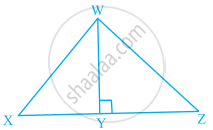Advertisements
Advertisements
प्रश्न
In a ΔABC, AB = 15 cm, BC = 13 cm and AC = 14 cm. Find the area of ΔABC and hence its altitude on AC ?
उत्तर

Now ,
`2s+a+b+c`
`⇒S=1/2(a+b+c)`
`⇒s=((15+13+14)/2)cm`
`⇒=21cm`
∴area of a triangle= `sqrt(s(s-a)(s-b)(s-c))`
`=sqrt(21(21-15)(21-14)(21-13)) cm^2`
`=sqrt(21xx6xx8xx7)cm^2`
`=84cm^2`
Let BE be perpendicular (⊥er) to AC
Now, area of triangle = `84 cm^2`
`⇒1/2xxBExxACxx84`
`⇒BE=(84xx2)/(AC)`
`BE=168/14=12cm`
∴Length of altitude on AC is 12 cm
APPEARS IN
संबंधित प्रश्न
If A(4, –6), B(3, –2) and C(5, 2) are the vertices of ∆ABC, then verify the fact that a median of a triangle ABC divides it into two triangle of equal areas.
Find the area of the quadrilateral ABCD whose vertices are respectively A(1, 1), B(7, –3), C(12, 2) and D(7, 21).
In each of the following find the value of 'k', for which the points are collinear.
(7, -2), (5, 1), (3, -k)
Prove that the points (2a, 4a), (2a, 6a) and `(2a + sqrt3a, 5a)` are the vertices of an equilateral triangle.
If the coordinates of the mid-points of the sides of a triangle are (3, 4) (4, 6) and (5, 7), find its vertices.
Find the area of Δ ABC whose vertices are:
A (1,2) B (-2,3) and C (-3,-4)
In ∆PQR, PR = 8 cm, QR = 4 cm and PL = 5 cm. 
Find:
(i) the area of the ∆PQR
(ii) QM.
If the points A(1, 2), O(0, 0) and C(a, b) are collinear, then ______.
Find the area of the triangle whose vertices are (–8, 4), (–6, 6) and (–3, 9).
Ratio of the area of ∆WXY to the area of ∆WZY is 3:4 in the given figure. If the area of ∆WXZ is 56 cm2 and WY = 8 cm, find the lengths of XY and YZ.

